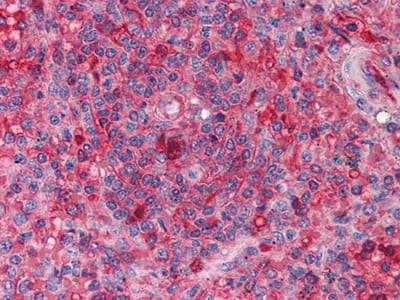
| WB | 咨询技术 | Human,Mouse,Rat |
| IF | 咨询技术 | Human,Mouse,Rat |
| IHC | 1/200 - 1/1000 | Human,Mouse,Rat |
| ICC | 技术咨询 | Human,Mouse,Rat |
| FCM | 咨询技术 | Human,Mouse,Rat |
| Elisa | 1/10000 | Human,Mouse,Rat |
| Aliases | TIC; JAP3; MOP3; BMAL1; PASD3; BMAL1c; bHLHe5; MGC47515; ARNTL |
| Entrez GeneID | 406 |
| clone | 1C5 |
| WB Predicted band size | 68.7kDa |
| Host/Isotype | Mouse IgG1 |
| Antibody Type | Primary antibody |
| Storage | Store at 4°C short term. Aliquot and store at -20°C long term. Avoid freeze/thaw cycles. |
| Species Reactivity | Human |
| Immunogen | Purified recombinant fragment of human ARNTL expressed in E. Coli. |
| Formulation | Ascitic fluid containing 0.03% sodium azide. |
+ +
以下是3篇关于ARNTL(BMAL1)抗体的参考文献及其摘要内容的简要概括:
---
1. **文献名称**: "Functional Consequences of a CK1δ Mutation Causing Familial Advanced Sleep Phase Syndrome"
**作者**: Patke A, et al.
**摘要**: 研究利用ARNTL特异性抗体进行免疫沉淀和Western blot分析,揭示了CK1δ突变如何破坏BMAL1-CLOCK复合物的稳定性,进而导致人类昼夜节律失调相关的睡眠相位前移综合征。
---
2. **文献名称**: "Transcriptional Architecture of the Mammalian Circadian Clock"
**作者**: Koike N, et al.
**摘要**: 通过ChIP-seq和ARNTL抗体,系统性绘制了核心生物钟蛋白(包括BMAL1)在小鼠肝脏中的全基因组结合位点,阐明了昼夜节律基因调控网络的层级结构。
---
3. **文献名称**: "CRY1/2 Selectively Repress PPARδ and Limit Exercise Capacity"
**作者**: Zhang Y, et al.
**摘要**: 研究使用ARNTL抗体进行共免疫沉淀实验,揭示了生物钟蛋白CRY1/2通过直接结合并抑制BMAL1-PPARδ转录复合物,影响运动代谢调控的分子机制。
---
4. **文献名称**: "A Serum Shock Induces Circadian Gene Expression in Mammalian Cells"
**作者**: Balsalobre A, et al.
**摘要**: 早期经典研究利用ARNTL抗体进行免疫荧光染色,首次证明血清刺激可重置培养细胞的生物钟振荡,并验证BMAL1蛋白的核质穿梭与昼夜节律相位调控相关。
---
这些文献涵盖了ARNTL抗体在蛋白质互作分析(IP/WB)、基因组结合研究(ChIP-seq)、亚细胞定位(免疫荧光)等关键应用场景,为相关研究提供了方法学参考。
The ARNTL (Aryl Hydrocarbon Receptor Nuclear Translocator-Like) antibody is a crucial tool for studying the ARNTL protein, also known as BMAL1. a core component of the molecular circadian clock. ARNTL forms a heterodimer with CLOCK, driving the transcription of circadian rhythm-regulated genes (e.g., *Period* [*Per*] and *Cryptochrome* [*Cry*]) by binding to E-box promoter elements. This protein-antigen plays a pivotal role in maintaining 24-hour physiological rhythms, influencing metabolism, immune function, and cellular differentiation. Dysregulation of ARNTL is linked to sleep disorders, metabolic diseases, and cancer.
ARNTL antibodies are widely used in circadian biology research to detect protein expression, localization, and interaction partners. They enable techniques like Western blotting, immunofluorescence, chromatin immunoprecipitation (ChIP), and immunohistochemistry. Specificity for ARNTL is critical due to structural similarities within the bHLH-PAS protein family. Validated antibodies help dissect ARNTL's roles in tissue-specific circadian regulation or disease contexts.
Recent studies also explore ARNTL's non-circadian functions, such as oxidative stress responses and aging. Researchers rely on high-quality ARNTL antibodies to investigate its post-translational modifications (e.g., phosphorylation) or tissue-specific isoforms. Commercial antibodies often target conserved regions (e.g., N-terminal domain), but validation via knockout controls remains essential. Overall, these antibodies are indispensable for unraveling the complexity of circadian mechanisms and their systemic impacts.
(Word count: 248)
×